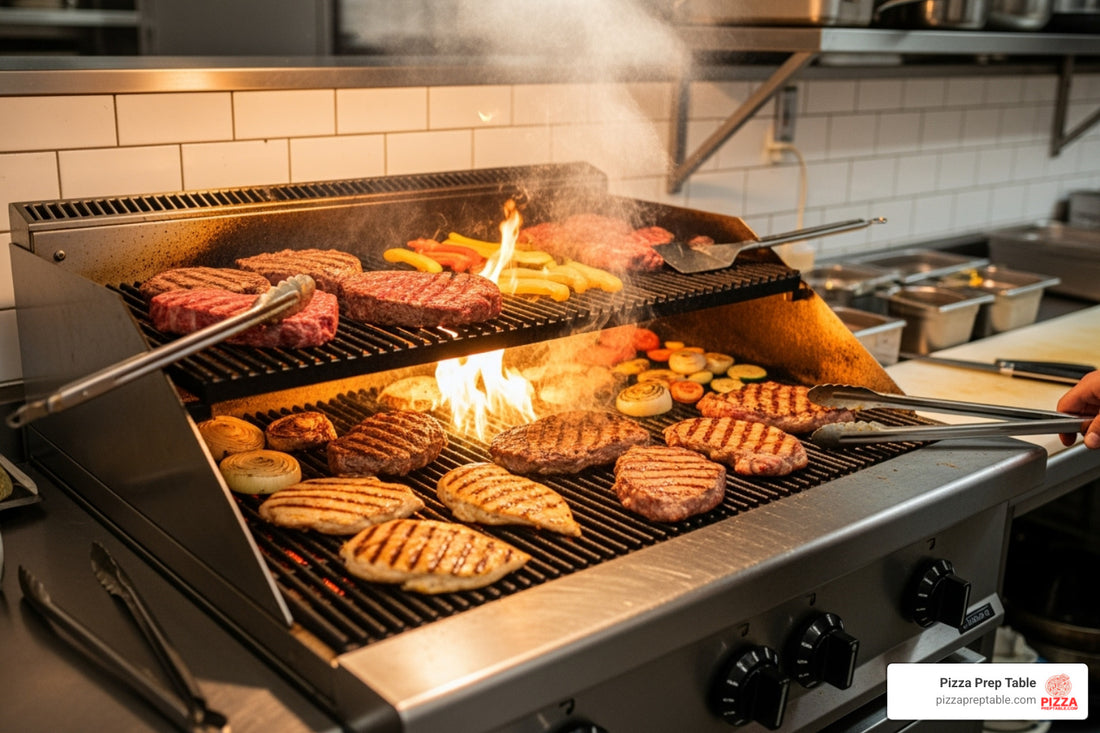
Everything You Need to Know About Char-Broilers
Share
Understanding the Char-Broiler
For any pizzeria owner or restaurant manager, understanding the char-broiler is essential for serving delicious, smoky dishes. A char-broiler is a cooking device used in commercial kitchens that features grates heated from below. It uses dry, direct heat to cook food, adding a signature smoky flavor and distinct grill marks.
From juicy steaks to perfectly seared vegetables, the char-broiler brings a unique flavor and texture to any menu. As a staple in commercial kitchens, it delivers that sought-after smoky taste and appearance that customers love. Knowing its role is key to maximizing your kitchen's productivity.
I'm Sean Kearney, and my passion for restaurant equipment comes from seeing how high-quality tools contribute to a kitchen's success. My experience has shown me how the right char-broiler can lift a restaurant's offerings.
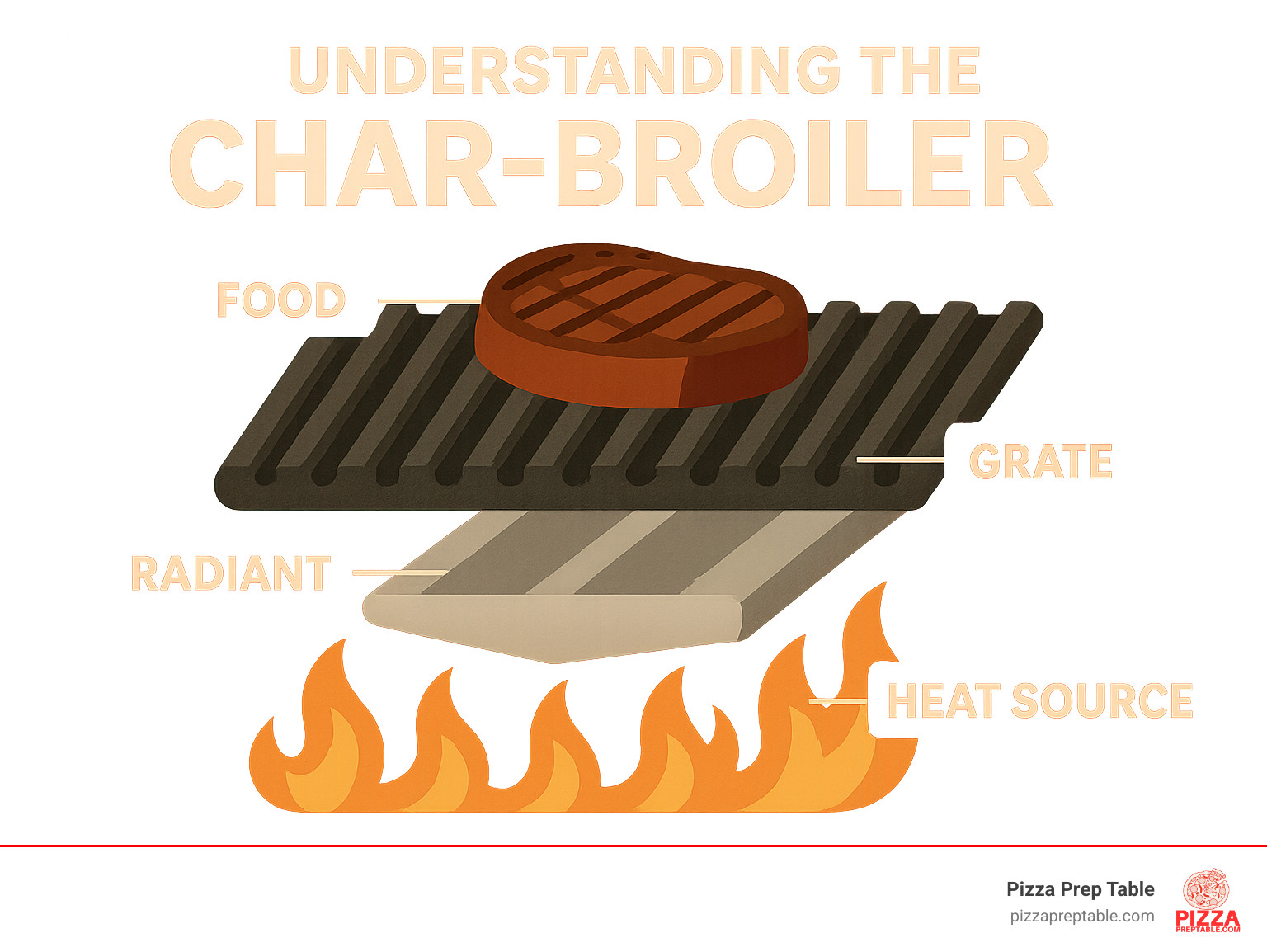
Easy char-broiler glossary:
What is a Char-Broiler and How Does It Work?
A char-broiler is the powerhouse of commercial grilling. It's an under-fired broiler that brings the magic of outdoor grilling into a professional kitchen with improved power and reliability.
A char-broiler uses dry heat cooking exclusively. Intense heat from a source below the cooking grates creates beautiful sear marks and locks in juicy flavors. This process relies on three heat transfer principles working in unison.
Convection circulates hot air for even cooking. Conduction occurs when food makes direct contact with the hot grates, creating classic grill marks. The most significant principle is radiation, specifically infrared energy, which radiates from the heat source to cook food quickly and efficiently.
When temperatures exceed 311°F (155°C), the Maillard reaction begins. This is the scientific process responsible for the incredible charbroiled flavor we all crave, changing proteins and sugars into complex, savory compounds. You can learn more about the science behind char-grilled flavor and how it works.
As food cooks, natural fats and juices drip onto the superheated surfaces below. These drippings instantly become vaporized grease, creating aromatic smoke that rises and infuses the food with its distinctive smoky taste.
This combination of intense heat, the Maillard reaction, and flavorful smoke makes a char-broiler a valuable asset in any commercial kitchen, delivering restaurant-quality results that keep customers returning.
Anatomy of a Commercial Char-Broiler
To understand how a commercial char-broiler delivers consistent, mouth-watering results, it's important to look at its system design. Every unit relies on a symphony of components working together to create that signature charbroiled flavor.
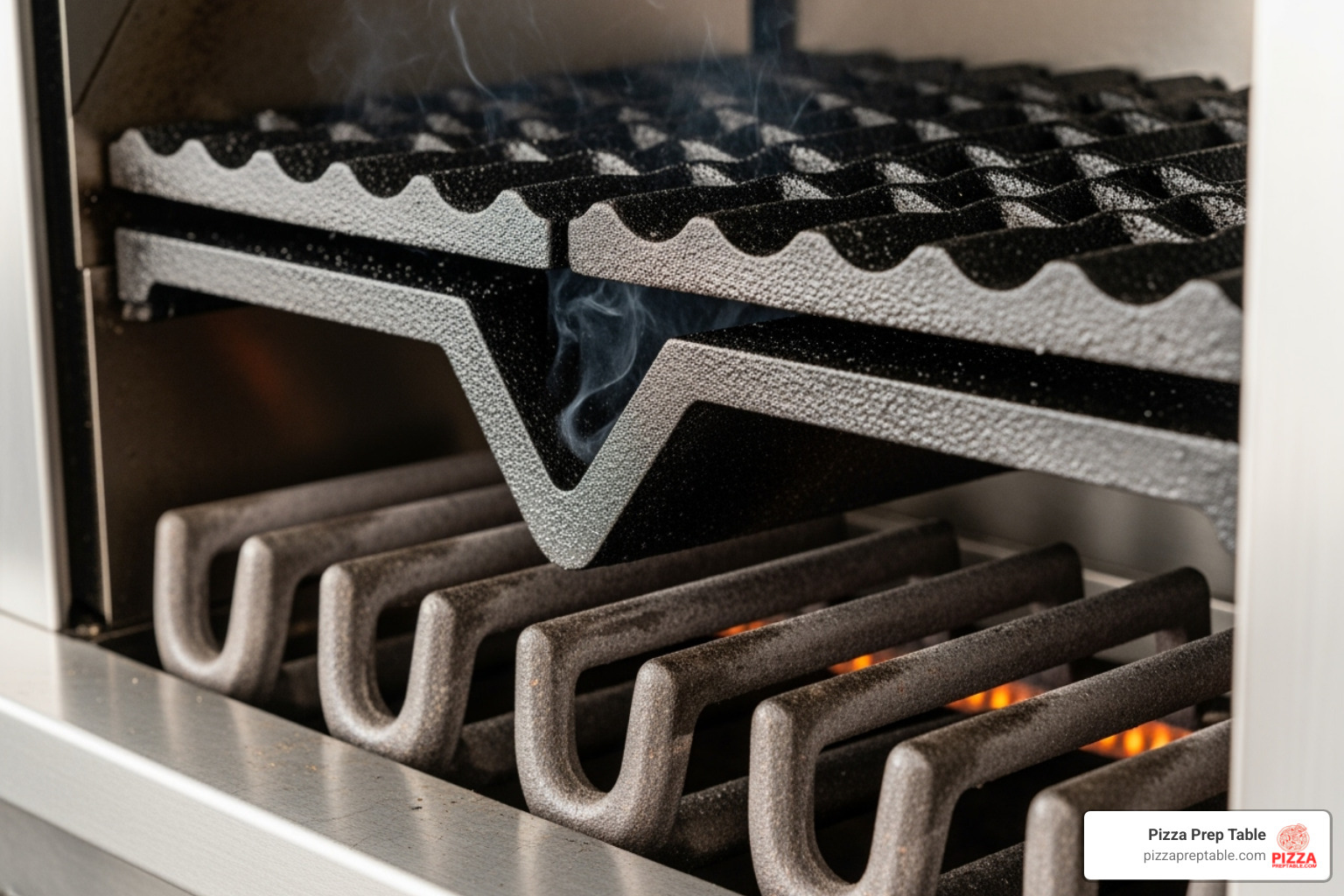
Three key components define a char-broiler: the burners that generate heat, the radiants that distribute it, and the grates where the cooking happens. Each piece impacts performance, and understanding their roles helps you maximize your investment.
The Power Source: Burners
The burners are the powerhouse of your char-broiler. Most commercial units run on natural gas or propane, with serious BTU ratings from 15,000 to 30,000 BTU per burner. This power is enough to handle the busiest dinner rush.
Burner spacing is crucial for even cooking, with burners typically positioned every 12 to 15 inches. This design ensures better heat distribution and control over different cooking zones. Independent controls for each burner allow you to create different heat zones across the cooking surface, helping manage natural hot spots that develop as convective heat draws toward the center.
The Heat Diffuser: Radiants
Located above the burners, radiants are the unsung heroes of heat diffusion. They spread the intense flame evenly across the cooking surface while protecting burners from grease drippings. They are also key to creating the signature smoky flavor.
- Cast iron radiants are the industry standard. They are durable, excellent at re-radiating heat, and protect the burner system from grease clogs, delivering consistent, searing heat.
- Lava rock offers a different approach. These porous volcanic stones sit above the burners, catching meat drippings. When the drippings hit the hot lava rock, they vaporize, creating a distinctive charcoal-like smoky flavor. However, lava rocks require regular rotation and eventual replacement.
- Ceramic briquettes are a middle ground. They function similarly to lava rock for flavor improvement but are generally easier to clean and maintain, making them practical for busy kitchens.
Your choice of radiant material directly affects your food's flavor profile, your maintenance routine, and long-term costs.
The Cooking Surface: Grates
The grates are where food meets heat, and in commercial kitchens, cast iron grates are king due to their superior heat retention and durability.
Modern grate designs offer great versatility. Reversible grates are popular, with a "thin" side for sharp sear marks on steaks and a "thick" side for delicate items like fish. Adjustable grates allow you to position sections flat or at an angle to move food farther from the flames, which is perfect for managing hot spots or reducing flare-ups.
Many units feature sectional grates that can be removed independently for easier cleaning. The key to great branding is achieving beautiful caramel-colored grill marks, and the right grate design makes this much easier to accomplish consistently.
Types of Commercial Char-Broilers
Not all char-broilers are created equal. Similar to choosing other kitchen equipment, selecting the right char-broiler requires understanding the different types available based on power sources and heat source types.
| Feature | Gas Radiant Char-Broiler | Gas Lava Rock Char-Broiler | Electric Char-Broiler |
|---|---|---|---|
| Heat Source | Gas burners heat metal radiants, which radiate heat to grates. | Gas burners heat porous lava rocks, which radiate heat to grates. | Electric heating elements directly heat grates or radiants. |
| Flavor Profile | Consistent, clean grill flavor; drippings vaporize on radiants. | Distinct, smoky, charcoal-like flavor from vaporized drippings on lava rocks. | Clean, consistent grill flavor; no direct flame, so less smoky. |
| Maintenance | Easier to clean; radiants protect burners from drippings. | Requires regular rotation and replacement of lava rocks; internal components may wear faster. | Generally easy to clean; elements often lift for access. |
| Best For | High-volume kitchens needing predictable results and easy cleaning. | Operations seeking a strong smoky flavor, similar to charcoal grilling. | Kitchens without gas lines (e.g., sub-basements, high-rise buildings), or those prioritizing precise temperature control. |
Gas vs. Electric Char-Broilers
The biggest decision is choosing between gas char-broilers and electric char-broilers. Gas char-broilers are dominant in commercial kitchens, running on natural gas or propane. They heat up fast, reach high temperatures, and respond immediately to adjustments. The trade-off is that they are energy-hungry and require proper gas lines and ventilation. For more insights, see our guide on Fueling the Fire: Choosing Between Char-Broiler Gas and Charcoal.
Electric char-broilers are lifesavers in kitchens without gas lines. They offer precise temperature control and are generally more energy-efficient. Their heating elements often lift for easy cleaning. However, they take longer to heat up and don't produce the same direct-flame flavor. Your choice often comes down to installation flexibility and kitchen requirements.
Radiant vs. Lava Rock: A Flavor and Maintenance Comparison
If you choose gas, you'll next decide between radiant heat and lava rock. This choice impacts both the flavor profile and your daily maintenance routine.
Radiant char-broilers use metal plates to distribute heat evenly. When drippings hit these hot surfaces, they vaporize, creating a consistent, clean charbroiled taste. The radiants also protect the burners, making them easier to clean and ideal for high-volume operations where consistency is key.
Lava rock char-broilers use porous rocks that absorb drippings, creating an intense, charcoal-like smoky flavor. This authentic taste comes with maintenance differences, as the rocks need regular rotation and eventual replacement. This means more cleaning effort and higher long-term costs. The decision comes down to whether you prefer the subtle flavor of radiant heat or the pronounced smokiness of lava rock.
Operational and Maintenance Essentials
Your char-broiler is a vital tool for creating mouth-watering, smoky dishes. Proper operation and regular maintenance will ensure it performs at its best, lasts longer, and keeps your kitchen running smoothly.
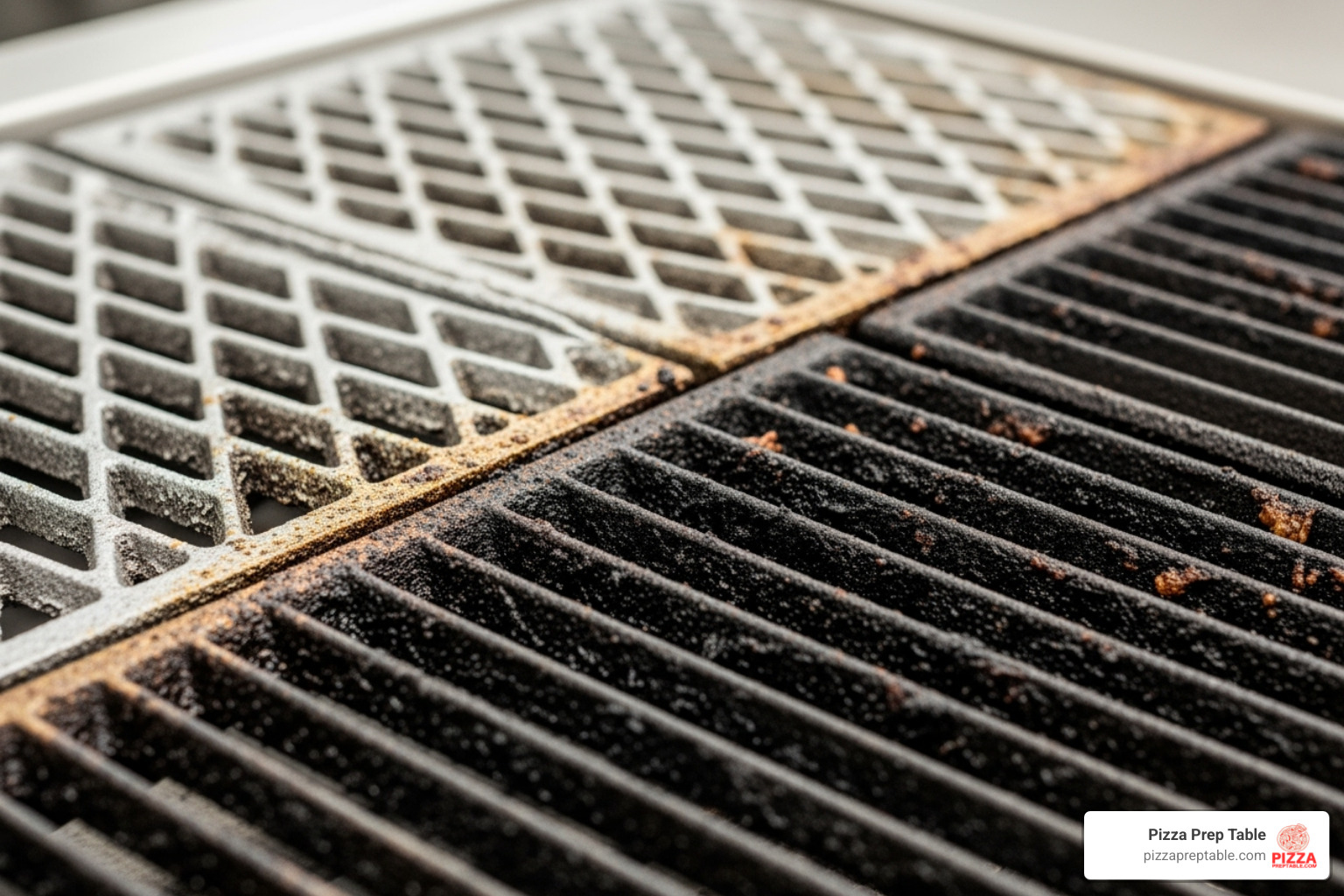
Operating Your Char-Broiler Effectively
Getting the most from your char-broiler means understanding its power. These units reach high temperatures, often 550°F and above, with some advanced models hitting a 1600°F hearth temperature for rapid searing. A standard gas radiant char-broiler typically operates between 250°F and 550°F.
Be aware that temperatures across the cooking surface aren't always uniform. Hot spots and cold zones can develop, but experienced chefs learn to use these to their advantage by placing food strategically or adjusting the grates. In terms of energy, char-broilers can consume 60,000 to 390,000 BTU/hr, so smart operation can significantly impact your operating costs.
Most importantly, ventilation is paramount. Char-broilers produce significant heat, smoke, and grease vapor, requiring a robust ventilation hood system and a fire suppression system. This is crucial for safety and meeting local fire codes. Investing in good ventilation is non-negotiable.
Cleaning and Maintenance for Longevity
Regular cleaning protects your investment, prevents costly downtime, and ensures your char-broiler delivers consistent flavor. A simple routine can keep your unit in top shape.
Daily Cleaning:
- Grates: Scrape the grates clean after service. For cast iron, consistent cleaning and grate seasoning are key to performance.
- Grease Tray/Drip Pan: Empty and clean the removable grease tray daily to prevent fire hazards and off-flavors.
- Exterior: Wipe down the stainless steel exterior to keep it looking professional.
Periodic Deep Cleaning:
- Radiant Cleaning: If applicable, remove and clean radiants to prevent grease buildup and ensure efficient heat transfer.
- Lava Rock/Briquette Maintenance: Rotate lava rocks for even wear and replace them when they become saturated or brittle.
- Burner Inspection: With the unit off and cool, check burners for debris or blockages to ensure even flames.
While daily care is vital, regular professional servicing can catch small issues before they become major problems. Warranties typically cover manufacturing defects, not damage from improper maintenance or misuse. A little preventive care goes a long way.
Choosing the Right Char-Broiler for Your Kitchen
Picking the perfect char-broiler is a critical decision that affects your menu and daily operations. Whether you're running a cozy pizza joint or a busy steakhouse, making the right choice is essential for success.
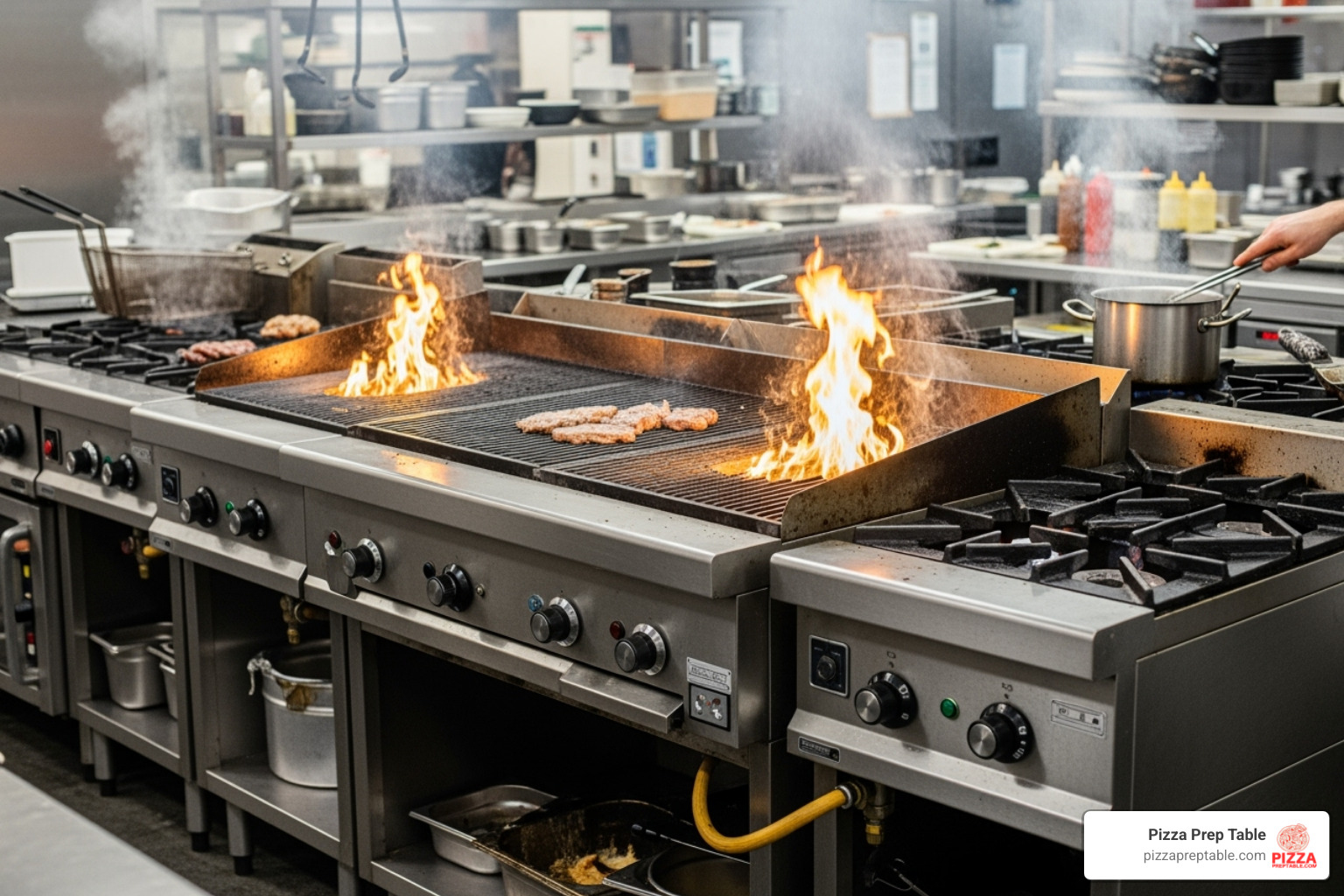
At PizzaPrepTable.com, we've helped countless owners steer this choice. This guide will give you the confidence to select the right unit for your kitchen.
Commercial Char-Broiler vs. Residential Grill
It's crucial to understand the difference between a commercial char-broiler and a residential grill. Commercial char-broilers are heavy-duty workhorses built with thick stainless steel and cast iron to withstand the constant use of a busy kitchen. Residential grills are designed for occasional backyard use and are not built to handle the volume or intensity of a commercial setting.
Key differences include construction, power, and design. Commercial units have much higher BTU outputs (often 20,000 to 40,000 BTU per burner) and are designed for open-surface cooking under powerful ventilation hoods. They are typically 24 to 72 inches wide and require robust ventilation systems and grease management. Using a residential grill in a commercial kitchen is a recipe for frustration and safety hazards. For more details, you can read about the key differences between commercial and home grills.
Key Factors for Your Purchase Decision
To find your perfect char-broiler, you need to assess your specific needs.
- Menu and Volume: What will you be grilling, and how much? A high-volume steakhouse needs a larger, more powerful unit than a cafe grilling vegetable sides.
- Kitchen Space: Measure your available area carefully. Freestanding models offer maximum capacity but require floor space, while countertop models are ideal for tight kitchens. If space is a major constraint, our guide to compact char-broiler picks can help.
- Fuel Availability: Is your kitchen set up for natural gas or propane? If gas isn't an option, an electric char-broiler is a great alternative.
- Flavor Profile: Do you prefer the intense, smoky flavor of a lava rock system or the consistent, cleaner taste of radiant heat? Consider the maintenance trade-offs.
- Budget: Look beyond the initial price. Factor in operating costs, maintenance, and expected lifespan. Commercial char-broilers range from a few hundred to several thousand dollars.
- Safety Certifications: Ensure any unit you consider is NSF and ETL certified to meet health and safety standards.
By honestly evaluating your needs, you'll find a char-broiler that will serve your business well for years.
Frequently Asked Questions about Char-Broilers
When it comes to char-broilers, certain questions come up time and again in busy kitchens. Here are concise answers to some of the most common ones.
How hot does a commercial char-broiler get?
Commercial char-broilers are built for intense heat. Most models operate with a cooking surface temperature of 550°F and above. This is what creates a perfect sear and locks in juices. The internal hearth temperature can be even more extreme, with some high-performance units reaching 1600°F. This intense heat is what enables the Maillard reaction, creating the rich, complex flavor that defines charbroiled food.
Can you use wood chips in a gas char-broiler?
Standard gas char-broilers are not designed for wood chips. Adding wood directly can cause dangerous flare-ups and damage the equipment. The signature smoky flavor in a traditional char-broiler comes from vaporized drippings—fats and juices that hit the hot radiants or lava rocks and turn into flavorful smoke. If you want authentic wood-fired taste, look for specialized hybrid models that have integrated, sealed drawers for safely burning wood chips.
What's the main difference in taste between radiant and lava rock char-broilers?
The flavor difference comes from how food drippings interact with the heat source.
- Radiant char-broilers produce a cleaner, more predictable charbroiled taste. Drippings vaporize on the hot metal radiants, creating a consistent smoky note that complements the food's natural flavor.
- Lava rock char-broilers deliver a more intense, charcoal-like flavor. The porous rocks absorb and then incinerate the drippings, creating a deeper, more pronounced smokiness reminiscent of traditional charcoal grilling. This dripping absorption creates richer smoke but requires more maintenance.
Conclusion
We've covered a lot, from the science of the Maillard reaction to the practical differences between radiant and lava rock systems. We've explored how these essential machines work, what types are available, and how to choose the right one for your kitchen.
Understanding how to operate your char-broiler effectively and, most importantly, how to keep it clean and well-maintained, is the key to longevity and performance. A little daily care ensures your investment will deliver delicious results for years.
The char-broiler is a culinary superstar. Its versatility allows you to grill everything from steaks and chicken to fish and vegetables, all with irresistible grill marks and a signature smoky flavor. The searing power and flavor benefits of a well-chosen char-broiler are undeniable for any commercial kitchen.
At PizzaPrepTable.com, we are your trusted partner in finding the perfect equipment. We offer a huge selection of commercial cooking equipment, including a diverse range of char-broilers. Our expert team is here to guide you through the options and provide flexible financing to help you make the best choice for your business.
Ready to bring incredible charbroiled flavor to your menu?
Explore Our Full Range of Commercial Cooking Equipment today.
